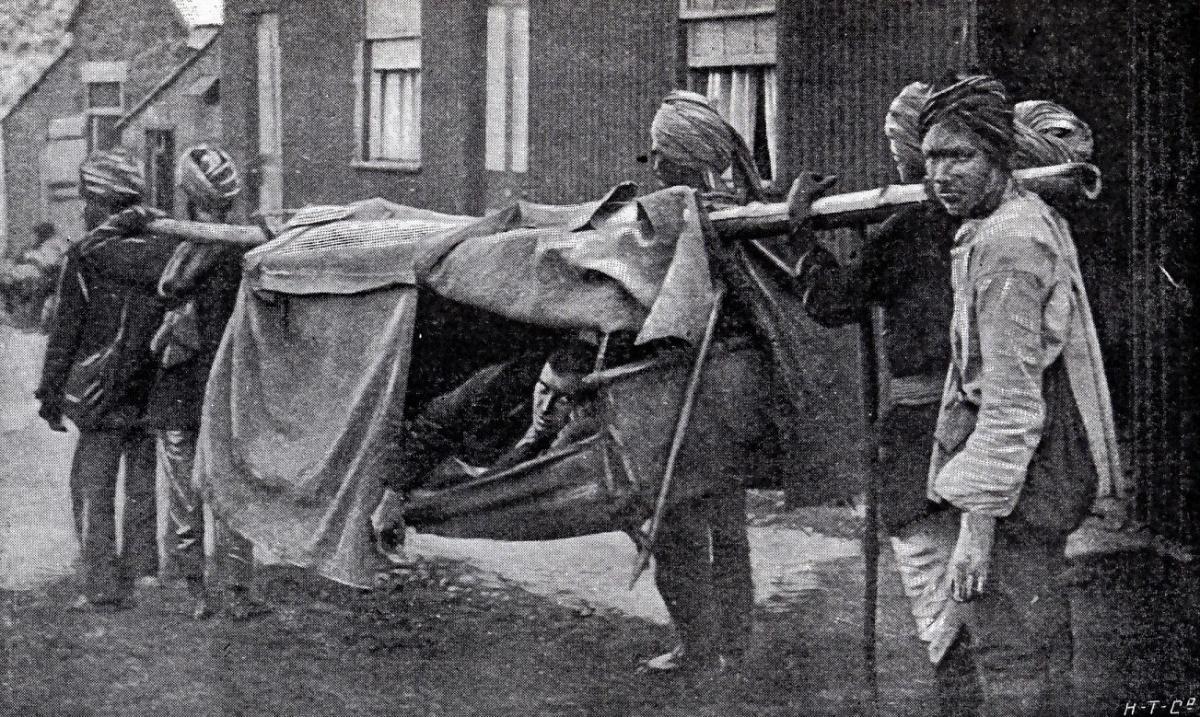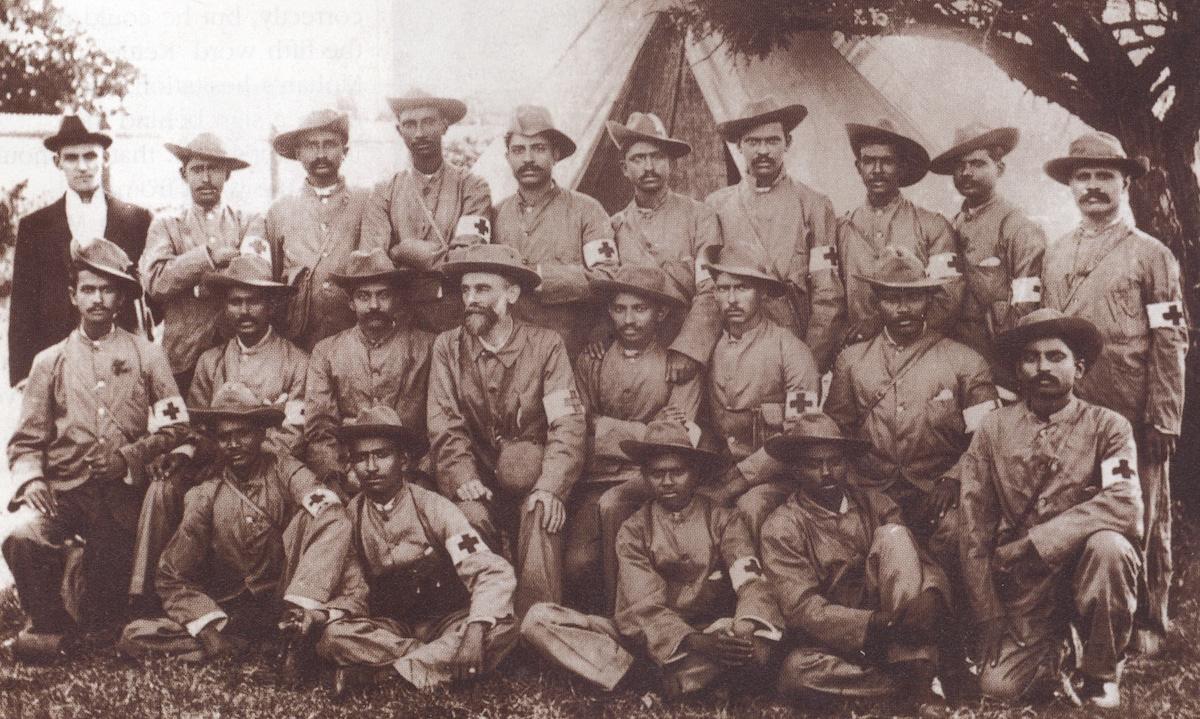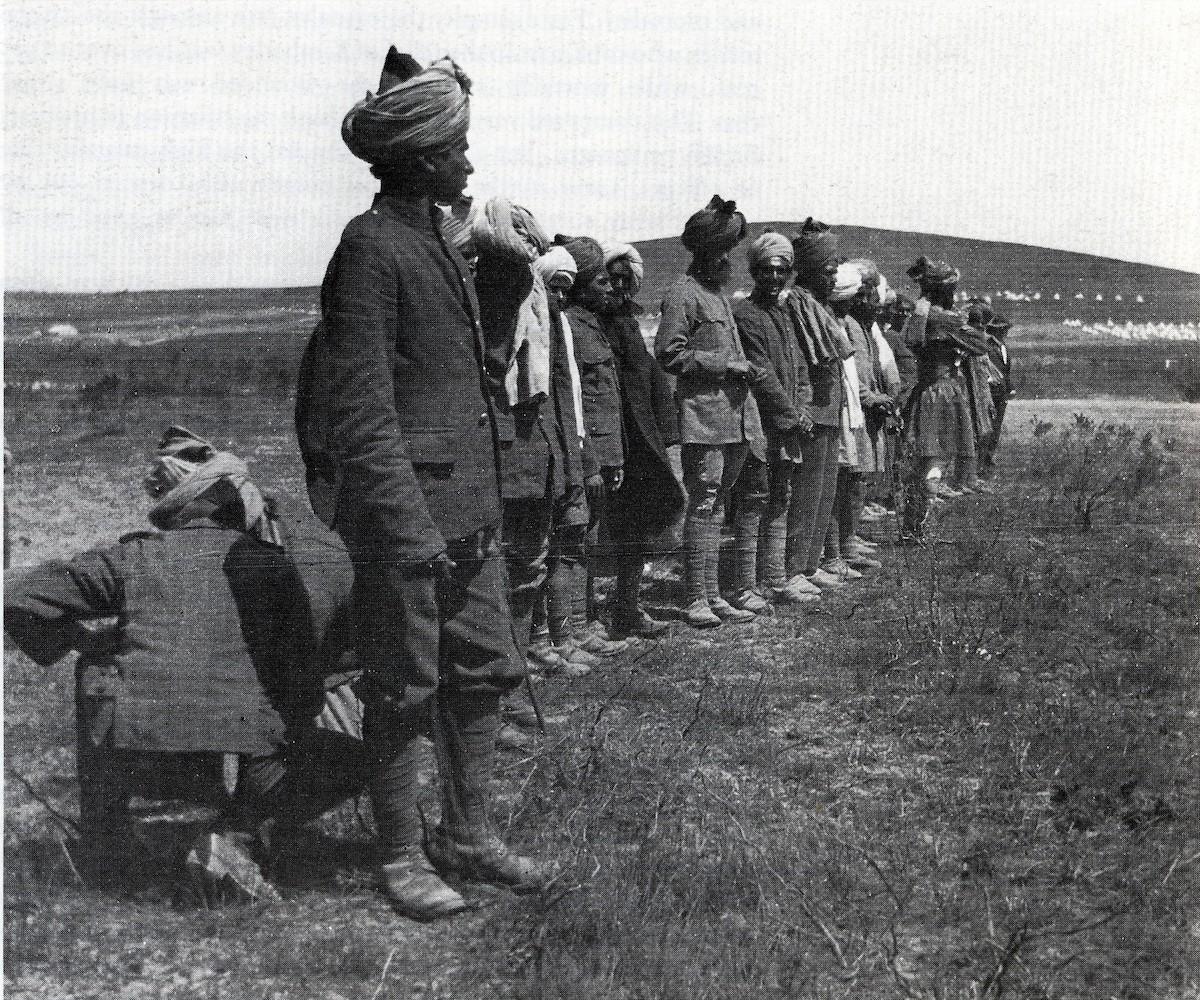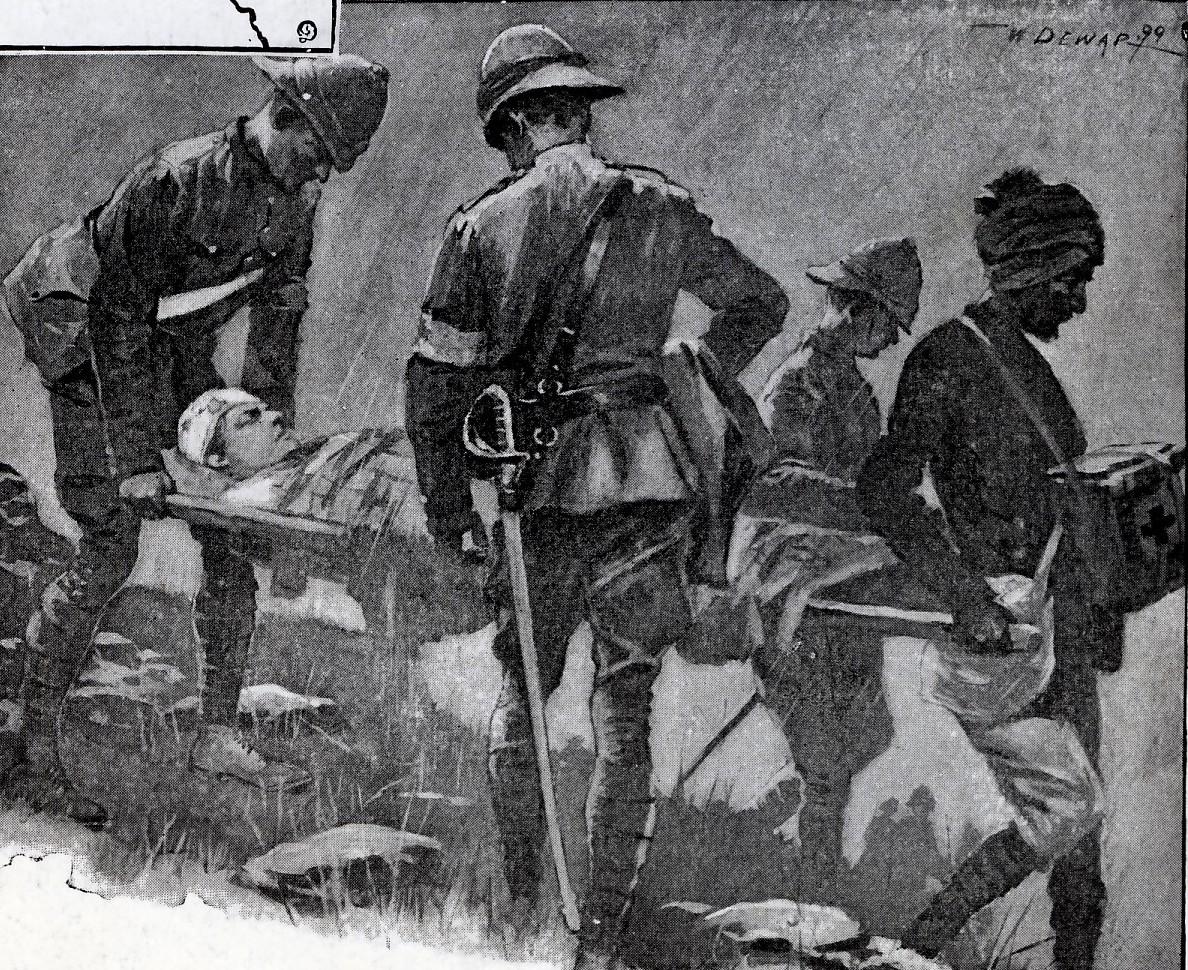
Disclaimer: Any views expressed by individuals and organisations are their own and do not in any way represent the views of The Heritage Portal. If you find any mistakes or historical inaccuracies, please contact the editor.
There are a number of myths around the formation, members, service and disbandment of the Natal Volunteer Indian Ambulance Service during the Boer War. Prompted by an enquiry by a fellow collector, I was lucky enough to find a wealth of information in the Talana Museum archives.
The Legend
"In 1893 an attorney-at-law, Mohandas K. Gandhi, arrived in Natal on a brief legal assignment. He decided to remain, on learning that disenfranchisement of Indians was intended. Together with influential others from the Indian community, he founded “The Natal Indian Congress” and became editor of “Indian Opinion”. He conceived of a new technique of political resistance based on the methods of “satyagraha” (“soul force”) and derived from the teachings of the pacifist Jain sect of Hinduism, a technique of resisting an objectionable law, if need be by enduring suffering, but without resorting to violence or ceasing to respect those who governed the people or enforced the law.
During his sojourn in South Africa, two field units were raised and commanded by Mohandas K. Gandhi from amongst his fellow countrymen then resident in Natal; one in 1899 (Indian Ambulance Corps) and the other in 1906 (Indian Stretcher-bearers Corps).
Indian stretcher bearer corps. Gandhi centre 5th from left.
Being unable to become combatants, Gandhi proposed that Indian volunteers serve as stretcher bearers together with the 1000 strong Natal Volunteer Ambulance Corps (who were made up largely from men who had fled the Rand before the outbreak of the war) organized by Colonel T. Gallwey, Principal Medical Officer of Natal. This offer was initially declined. However, General Buller, later recognizing a need for assistance, intervened and had the decision reversed.
Early December 1899 saw Gandhi applying pressure by maintaining contact with the Colonial Office. The Reverend Doctor Booth was seconded to the group. On 11 December Gandhi telegraphed Prajee Bhinbhai Bellair to have him alert the volunteers to stand prepared, and he and Dr. Booth met with the Colonial Secretary the following day to finalize arrangements.
The Corps was sent forward by train on 14 December 1899, reaching the Field Hospital at Chieveley the following day The task of the Indian Bearer Corps was defined as having to take the wounded brought by the Natal Volunteer Ambulance Corps from the battlefield and carry them to the railhead. They had been given no combat training as there was no expectation of their serving under fire. However, they were immediately employed in assisting the wounded at the battle of Colenso. On 17 December 1899 the Corps moved to Estcourt and peculiarly was temporarily disbanded two days later.
Reformed on 07 January 1900, the Corps was again stationed at Esctcourt. On 24 January 1900, at the battle of Spion Kop, the Corps agreed to serve under fire and carried the wounded from the field to base hospital at Frere.
The Corps was disbanded at the end of February 1900 after Ladysmith had been relieved.
The initial formation, the Indian Ambulance Corps, served with distinction at Colenso, Spion Kop and Vaalkranz and had a strength of 34 Leaders and 1100 men. Being civilians and unpaid volunteers, their members were not considered to receive medals (nor, incidentally, the Queen’s Chocolate). The Rev. Dr. Lancelot Parker Booth, the Medical Officer of the Corps, lobbied the Secretary of State for War, Sir John Broderick, for decorations on behalf of the Leaders. Field Marshall Lord Garnet Wolsely agreed to the proposition as he felt that, were the matter brought to Queen Victoria’s attention, she would have insisted that medals should be awarded”.
Only 34 members of the Indian Ambulance Corps received a Queen’s South Africa Medal. Leader S.N. Richards received the silver Queen’s South Africa medal with bars Tugela Heights and Relief of Ladysmith. The remainder received a Queen’s South Africa Medal without a bar.
There is some confusion concerning Booth’s submissions on which Leaders he felt deserved a medal. On 08 October 1900 he submitted 18 names. Yet his handwritten list (date unknown) lists 31. A combined list of these men comes to 40.
Indian stretcher bearers from Natal
The Reality
Firstly, the Natal Volunteer Indian Ambulance Services should not be confused with any other Imperial Indian Medical Services nor the Natal Volunteer Ambulance Corps. At best, there were 40 Leaders in the NVIAS and they served for only two months – 12 December 1899 to the termination of the Relief of Ladysmith campaign at the end of February 1900.
Although Gandhi would have indeed played a large part in raising the force from among his own countrymen, technically he would not have been the Commanding Officer. That would have been Reverend Doctor Booth, and it is in this capacity that he lobbied for medals for his Leaders.
“The task of the Indian Bearer Corps was defined as having to take the wounded brought by the Natal Volunteer Ambulance Corps from the battlefield and carry them to the railhead. They had been given no combat training as there was no expectation of their serving under fire. However, on 24 January 1900, at the battle of Spion Kop, the Corps agreed to serve under fire and carried the wounded from the field to base hospital at Frere”.
This statement has been interpreted to mean that members of the Corps were actually on top of Spioenkop, helping to carry the casualties off the actual battlefield. However, according to Hayward’s “The South African War Casualty Roll – The Natal Field Force”, no member of the Natal Volunteer Indian Ambulance Services was even scratched. This is hard to believe if they were in the thick of the action.
As one might expect, though, the Natal Volunteer Ambulance Corps suffered two dead and eleven wounded during the Spioenkop operations. But even these casualties were not necessarily sustained on the actual battlefield. According to Hayward, these casualties were sustained at “Spearman’s Camp and Venter’s Spruit”. This tends to suggest that “under fire'' in this case would possibly have been referring to the rear of the British positions or the crossing points across the Tugela River, which were subject to long range Boer fire.
Also the sentence "carried the wounded from the field” would mean from the hospital at Spearman’s Camp to Frère and not from the actual battle site.
“Being civilians and unpaid volunteers, …. Only 34 members of the Indian Ambulance Corps received a Queen’s South Africa Medal. Leader S.N. Richards received the silver Queen’s South Africa medal with bars Tugela Heights and Relief of Ladysmith. The remainder received a Queen’s South Africa Medal without a bar”.
This is not the case. Mike Rowan of Kloof also has a silver medal with clasps Tugela Heights and Relief of Ladysmith to David Vinden, so although these might have been the exception, more than one silver medal with bars was awarded.
The belief that the men were “unpaid volunteers” has circulated forever. However, the Natal Archives holds a payroll of the Corps, issued by the Department of Public Works - a copy of this documents is held by Talana Museum.
Thus are legends perpetuated?
Note by Pam McFadden
Many of the photographs of Indian stretcher bearers do not pertain to the Indian Ambulance Corps, but are of Indians from India, who were part of the Royal Army Medical Corps. Due to the date on inception of the Corps no local Indian stretcher bearers were present at the battles of Talana and Elandslaagte. There is information in the Talana Museum archives of local Indians, who came out to watch the battle of Talana from the edge of the town, and then who voluntarily assisted to carrying wounded from a field site into halls and churches in the town, that were being used to treat the wounded.
Removing men from the field after the Battle of Elandslaagte (W Dewar)
Incidentally, although we refer to the battle of Talana, it took 3 days before that became the accepted name – it was originally called the battle of Glencoe, then Dundee and finally Talana, being the name of the hill up which the British troops fought.
Pat Rundgren was born in Kenya and grew up in what was then Bechuanaland and Rhodesia. He has nearly 10 years infantry experience as a former member of the Rhodesian Security Services. He is passionate about and has a deep knowledge of the battles, the bush and Zulu culture. He has written numerous articles on military subjects and militaria collecting for overseas publications, has contributed to several books and is currently busy with his eighth book. His wide ranging knowledge and over 20 years guiding experience and unique story telling will bring events alive to his listeners. His books “What REALLY happened at Rorke’s Drift?” and on Isandlwana and Talana have gone into a number of reprints. He is a collector of militaria with special focus on medals. He also organises and conducts tours around the battlefields of KwaZulu-Natal and tours into Zululand to experience traditional and authentic Zulu culture and life style. Pat is currently the Chairperson of the Talana Museum Board of Trustees and one of the volunteer researchers.
Pam McFadden has spent many years researching the battlefields of KwaZulu-Natal. She has been interested in them since a young child. As a registered specialist guide on these battlefields for the past 40 years her knowledge about events and the people involved is considerable. Since 1983 as curator, Pam McFadden has developed the Talana Museum in Dundee into one of the finest in the country. As part of the museum collections she has collected and created an extensive museum archive, that holds many treasures.
References
- Talana Museum reference ABW 16201-2252.
Comments will load below. If for any reason none appear click here for some troubleshooting tips. If you would like to post a comment and need instructions click here.



